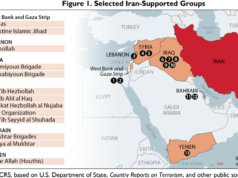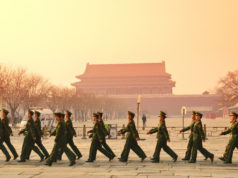Over the next 15 years, the United States and People’s Republic of China (PRC) will be the prime movers in the international energy market. U.S. energy production and exports will increase, while China will have a difficult time matching production with growing demand in the absence of economic and energy reform. However, China’s energy consumption growth rate will be tempered by a slowing economic growth rate.
Since the energy order is a subset of the larger American-dominated world order, there are two essential questions for the future of energy: Will the PRC continue to accept, however grudgingly, the world order in most of its dimensions, or more aggressively try to reshape it in accordance with its own perceived interests? For the U.S., the main strategic question is whether it will devote the economic and diplomatic resources necessary to preserving the liberal order it helped create.
The new energy story is twofold. First, the U.S. is becoming a major energy producer and exporter. While this will not lessen American interest in a low and stable oil price derived on the global market, it will change the nature of America’s relationship with existing suppliers and new purchasers. Second, China’s economy is stagnating and its relative external demand is slowing. China could develop relatively greater interest in a preferential or even strategic relationship with Iran, Iraq, or Russia. The U.S. may be less interested in bilateral energy and strategic relationships that it has had with countries such as Saudi Arabia, while retaining an interest in stability in the Middle East.
China’s Demand Shock and Its Geopolitical Consequences
Since the end of the Cold War, the greatest energy system change has been the massive growth of the Chinese economy and the energy demand shock it created. Because of its highly inefficient industrial and regulatory structure, China’s energy sector has become increasingly dependent on imports—between 53 and 58 percent and rising—mainly from the Middle East. China is dependent on imports for about 32 percent of its natural gas. Australia, Qatar, Malaysia, and Indonesia are China’s largest maritime liquid natural gas suppliers, while Turkmenistan, Uzbekistan, Kazakhstan, and Burma provide natural gas to the PRC via pipelines.
Protecting Overseas Energy Interests. As China developed new commercial and diplomatic relationships with major suppliers, particularly in the Gulf and Africa, Beijing grew concerned about supply disruptions along the long maritime expanse from Africa to China’s eastern seaboard. It feared terrorism, pirates, and political instability, but most of all it feared that the U.S. and its allies could cut off China’s energy supply in the event of a downturn in Sino-American relations. While revanchist historical claims, nationalism, and the potential of future energy production play a role in China’s assertive behavior in the South and East China Seas, China’s reliance on these seas to transport energy and export goods is probably the most important factor driving its more aggressive posture.
China’s answer to the vexing problem of protecting its energy supply has been threefold: (1) a more robust maritime military and diplomatic posture (new historic missions); (2) the state flagging of maritime commercial vessels and, more broadly, the use of international law; and (3) the development of diplomatic relations with and construction of pipelines from gas- and oil-producing countries in Central Asia.
The New Historic Missions. The People’s Liberation Army Navy (PLAN) has been implementing the new historic missions in three ways: (1) a naval task force deployed in the Gulf of Aden since 2008; (2) development of military forces able to project power into both the South China Sea and Indian Ocean, through which most of China’s imported energy travels; and (3) diplomatic and military logistics relationships and port calls in the Persian Gulf and Africa, most frequently in Oman, Yemen, and Djibouti.
In addition to building naval flotillas akin to carrier strike groups, the PRC is developing capabilities to protect its energy interests in three ways. First, it is growing its submarine force by beginning to foray into the Indian Ocean and the Gulf. Recently, a Chinese diesel submarine transited the Malacca Strait to make a port call in Colombo, Sri Lanka, before continuing on to the Gulf—the first known voyage by a Chinese submarine into the Indian Ocean. Although China’s submarine force does not have global power projection capability, its growing fleet of nuclear-attack submarines may be able to frequent the Indian Ocean and provide some retaliatory capability should the U.S. or other perceived hostile powers interdict Chinese energy supplies.
Second, China is engaging in sea lines of communication (SLOC) protection missions. The Gulf of Aden task force is a mission that has provided the PLA with an opportunity to learn how to project power far away from China’s shores, develop diplomatic and military relationships, and explore more permanent support for overseas activities. In 2014, the guided-missile frigate Jiangkai II was repositioned to the Mediterranean in support of removing chemical weapons from Syria. In April 2015, a PLAN flotilla conducted a non-combatant evacuation mission in Yemen, rescuing both Chinese and foreign nationals from the ongoing civil war. The PLAN is also developing aircraft carriers that can provide SLOC protection along China’s long maritime trade routes. China’s first carrier, the Liaoning, was commissioned in 2012.
Third, China is flagging more oil tankers as a security hedge. State-flagged tankers enjoy the protection of the flag state under international law; if a state-flagged vessel is interfered with, the state would have a legitimate claim that its sovereignty had been breached. Thirty-three percent of China’s large tankers are flagged, and this percentage is growing. (91 percent of India’s are flagged, whereas import-dependent South Korea and Japan flag 5 percent and 14 percent, respectively.)
These Chinese maritime security developments comprise a hedging strategy against U.S. interdiction and are signs of the gradual development of global maritime power. The latter would require a global basing infrastructure, a significant carrier-strike group fleet, and alliances of the kind the PRC has never had. Beijing has not yet had to make a firm decision about whether it wants this kind of maritime power projection capability.
Oil and Gas Pipelines. China has operational transnational oil or gas pipelines with Kazakhstan, Uzbekistan, Turkmenistan, and Russia. China also revived its plans to construct an oil-import pipeline from Myanmar through an agreement signed in March 2009 and began importing gas in September 2013.
China gets 4 percent of its imported oil from Kazakhstan and 9 percent from Russia—some by rail, some by sea, and some by pipeline. In 2013, it got about half of its imported gas—24.4 billion cubic meters—from Turkmenistan. While China’s pipeline plans have had some impact on Central Asia’s geopolitics, such as increased Sino-Russian competition for political influence in the region, they will not do much for China’s energy needs. Pipelines are expensive to build, and imports from them are more expensive than maritime-based imports. China imports 40 percent of its oil by sea and pipelines simply cannot replace that amount of oil.
The New Geopolitics and Energy Status Quo
The end of the Chinese demand shock will mean that China will be less frenetic about its energy strategy, giving it time to rethink how it implements its new maritime diplomatic and military strategies. The U.S. energy revolution is pushing the energy system back in a free-market direction by breaking the artificial production quotas favored by OPEC and undermining Russia’s ability to use energy as a weapon. China would have to accrue more power to pose this type of systemic challenge. It could do so by translating more of its resources into military power or by achieving diplomatic breakthroughs—for example, by allying with a major country such as Russia or Iran.
If China manages to create such a new alignment, it is doubtful that the energy system status quo will endure. For example, a Chinese-Iranian alliance could challenge the U.S. Fifth Fleet’s control of the Gulf, creating a security vacuum in the global provision of maritime security and in maintenance of political stability in the Gulf. The international energy market would likely balkanize and energy blocks would form, negatively affecting the price and availability of energy.
Consequently, the two most pertinent geopolitical questions as they relate to energy security are: is China both willing and able to pose a systemic challenge to the U.S., and will the U.S. have the power and will to continue to guarantee the international security system?
Scenario One: Present Trends Continue. This is the most likely scenario. U.S. production levels continue apace and U.S. net energy demand moves to zero, making the U.S. a net energy exporter. This scenario results in lower global prices and a global dollar-denominated gas market. Meanwhile, the Chinese economy grows at a slower rate and there is no real economic or energy reform. Energy production and consumption grow far more slowly than anticipated. Imports rise, but at a slower rate than they have over the last 15 years. Thus, the U.S. becomes a supplier nation while China remains a net importer.
China would still look to one or more of the potential major producers—Iran, Iraq, and Russia—to meet its demand. China may be in a better price- and supply-negotiating position than it has been over the past decade. It no longer experiences demand shock and could more gradually and deliberately choose its suppliers and contracts.
In this present-trends-continue scenario, the U.S. appears stronger and more threatening. Contrary to China’s more recent assessments of American power, the U.S. would be undergoing a strategic revival. It could assist South Korea, Japan, and Taiwan by helping arrange an allied energy purchaser, infrastructure, or logistical group to reshape how these allies buy and transport energy. The U.S. could also use this tool as it develops relationships with potential economic powerhouses such as India, Vietnam, and Indonesia. All three could see their energy demands skyrocket if they were to undertake major market reforms. With the U.S. as a reliable exporter, they could diversify their supply from Russia and the Middle East.
China, while less beholden to Middle Eastern suppliers, would still need a large volume of imports and would consider a truly meaningful alliance, possibly with Iran and/or Iraq. Although the PRC’s economy would be growing at a slower rate than it has in decades, China could still devote more resources to an increased global maritime posture, as it has already gained experience on which it can build. A Gulf ally could help China extend its reach into an energy-rich arena and complicate the strategic calculations of a potentially hostile U.S.
Another, perhaps more attractive, option for China is to really come to terms with Moscow on energy. That could lead to the setting aside of both historic and current mistrust in favor of a strategic alignment between the two nations. In theory, this makes great sense. A Chinese continental strategy would allow Beijing to avoid the treacherous politics of the Middle East and somewhat mitigate its dependence on extended maritime supply lines. It would be more attractive to China than an alliance with Iran or Iraq, as Beijing has greater experience dealing with Moscow than with Middle Eastern states. It might be able to establish more cooperative relations with Moscow in energy-producing Central Asian states.
Scenario Two: Chinese Reform. A second likely (though far less so) scenario is that China reforms both its economy and energy system. Its economic growth would not slow and its net energy demand would fall as its domestic energy production increases. The U.S. net energy demand would still be low, as its production picture is still rosy. The difference from scenario one is that both China and the U.S. would become wealthier, more powerful, and less dependent on energy imports.
China may be in a very favorable position, as former U.S. energy suppliers need the Chinese market more than Beijing needs them. China would be courted by Iraq, Iran, and Russia, placing China in a favorable position to negotiate supply contracts and new political and military arrangements in the Gulf and Africa. China could also be a more formidable geostrategic competitor, with leverage in the Middle East and Russia, and would have more resources to become a global military power. Rather than scrambling to catch up to the overseas activities of China’s energy companies, the PLA could get back on plan and develop the kind of global maritime power that the Chinese Communist Party wants on its own timeline.
This scenario places American allies such as Japan in a relatively less advantageous strategic position. They would still be in an energy-import-dependent position, with less clout than China among traditional suppliers. To retain its prime political position in Asia, the U.S. would prioritize alleviating the risks for its allies by becoming a robust energy exporter and by shoring up its strategic position in the Middle East to keep prices stable. It would remain involved in issues central to the Middle East’s power balance.
China would over time have the wealth and the power to pose a systemic-level threat to U.S. global leadership. It could focus more coercive power on the Asia-Pacific, shaping that region in accordance with Chinese interests. It could avoid dependencies on unstable regions while building a global maritime presence. It would have the leverage to exchange capital for energy and to align producers such as Iran, Iraq, and Russia with its global interests.
However, the U.S. would remain wealthy and powerful. Thus, the two countries could engage in a truly global security competition. The potential upside for the U.S. is that the global economy grows faster than in scenario one, and Beijing and Washington might mitigate their rivalry by finding ways to keep oil prices stable and low and to keep the global economy growing. Since an economically reformed China is likely to be relatively more open and pluralistic, the two countries may converge on basic issues of international management.
Scenario Three: The Best Outcome for China. A less likely but still plausible scenario is a world of lower U.S. production if political forces end the production boom, and Chinese reform leading to lower net demand. This is the worst outcome for the U.S., which would need to be very active in and dependent on the world market, while China would be less active.
Like scenario two, this would probably result in more Chinese geopolitical focus on gaining advantages in the Asia-Pacific. The death of the U.S. shale boom would tie Washington to the fortunes of unreliable suppliers. The U.S. would have less relative wealth and power to compete vigorously in Asia, and China might become the regional hegemon.
In this scenario, the U.S. will continue to be more like it was before the shale revolution—more solicitous of Gulf oil producing states and with less leverage over Iran and Russia. In the short term, allies dependent on U.S. energy imports may cheer that they are in the same boat as the U.S. and that, for a time, the U.S. is acting in ways that they are used to. They may be soothed that China may be relatively less interested in the major producing states. But a deeper concern would emerge that the U.S. is unable to protect the liberal order and therefore would be less able as an alliance partner.
Similar to the second scenario, a mitigating factor for the U.S. and its allies in scenario three is that deep Chinese reform will require political change. As in the second scenario, if China goes through its next phase of economic reform, the economy will require more rule of law, financial openness, and consumer choice, and the political system would be more open. Such change in China would mitigate but not reverse the downward trend in the U.S. geopolitical position.
Conclusion
Unless China undertakes major economic reforms, its growth will slow appreciably. This will put China in a relatively disadvantageous geopolitical position, mainly because of the consequences for Chinese power, but also because it is unlikely to reform its energy sector, meaning it will still be dependent on energy imports (though at a slower rate of growth) but with less relative national power.
Meanwhile, the most likely scenario for the U.S. is a continued production boom that lowers its net energy demand. It will have more wealth to potentially turn into military power, could arrange new energy supply relationships with key countries in Asia, and would approach the Middle East with more leverage and less dependence on particular relationships.
As it perceives the U.S. to be more powerful and menacing, China will still feel the need to grow its power-projection capabilities, even with relatively fewer economic resources. To do so, it will probably need an ally, thus ensuring that Iraq, Iran, and Russia will play an increasingly important role in the long-term Sino-American strategic competition. A Chinese ally would be the biggest change the world has seen in a very long time.
American allies in Asia—particularly Japan and South Korea—have a strong interest in a continued U.S. production boom and consequent revival of American strategic power. They could make a continued U.S. energy boom and a push for the U.S. to create new supply arrangements in Asia a high diplomatic priority in discussions. But the U.S. will need to determine whether and how it uses its positive energy profile as a tool of national power.
Daniel Blumenthal is the director of Asian Studies at AEI, where he focuses on East Asian security issues and Sino-American relations.





